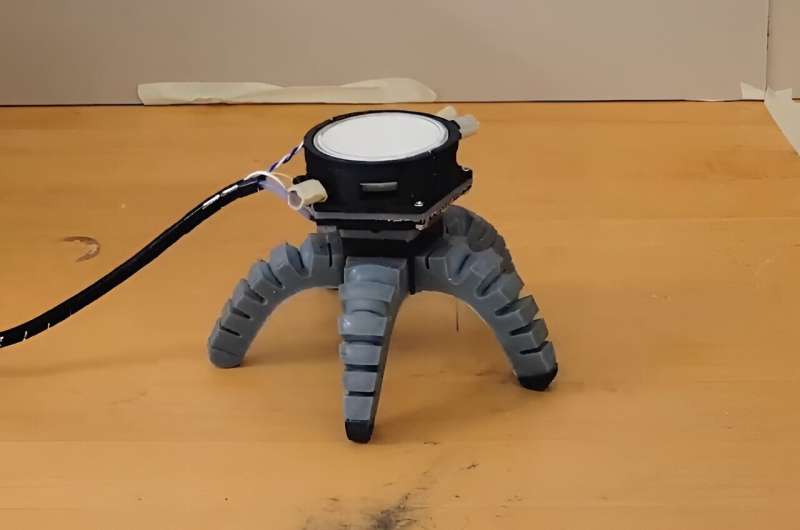This article has been reviewed according to Science X's editorial process and policies. Editors have highlighted the following attributes while ensuring the content's credibility:
fact-checked
peer-reviewed publication
trusted source
proofread
Biohybrid robots controlled by electrical impulses in mushrooms

Building a robot takes time, technical skill, the right materials—and sometimes, a little fungus.
In creating a pair of new robots, Cornell researchers have cultivated an unlikely component, one found not in the lab but on the forest floor: fungal mycelia. By harnessing mycelia's innate electrical signals, the researchers discovered a new way of controlling "biohybrid" robots that can potentially react to their environment better than their purely synthetic counterparts.
The team's paper, "Sensorimotor Control of Robots Mediated by Electrophysiological Measurements of Fungal Mycelia," is published in Science Robotics. The lead author is Anand Mishra, a research associate in the Organic Robotics Lab led by Rob Shepherd, professor of mechanical and aerospace engineering in Cornell Engineering, and the paper's senior author.
"This paper is the first of many that will use the fungal kingdom to provide environmental sensing and command signals to robots to improve their levels of autonomy," Shepherd said. "By growing mycelium into the electronics of a robot, we were able to allow the biohybrid machine to sense and respond to the environment. In this case we used light as the input, but in the future it will be chemical. The potential for future robots could be to sense soil chemistry in row crops and decide when to add more fertilizer, for example, perhaps mitigating downstream effects of agriculture like harmful algal blooms."
In designing the robots of tomorrow, engineers have taken many of their cues from the animal kingdom, with machines that mimic the way living creatures move, sense their environment and even regulate their internal temperature through perspiration. Some robots have incorporated living material, such as cells from muscle tissue, but those complex biological systems are difficult to keep healthy and functional. It's not always easy, after all, to keep a robot alive.
Mycelia are the underground vegetative part of mushrooms, and they have a number of advantages. They can grow in harsh conditions. They also have the ability to sense chemical and biological signals and respond to multiple inputs.
"If you think about a synthetic system—let's say, any passive sensor—we just use it for one purpose. But living systems respond to touch, they respond to light, they respond to heat, they respond to even some unknowns, like signals," Mishra said. "That's why we think, OK, if you wanted to build future robots, how can they work in an unexpected environment? We can leverage these living systems, and any unknown input comes in, the robot will respond to that."
However, finding a way to integrate mushrooms and robots requires more than just tech savvy and a green thumb.
"You have to have a background in mechanical engineering, electronics, some mycology, some neurobiology, some kind of signal processing," Mishra said. "All these fields come together to build this kind of system."
Mishra collaborated with a range of interdisciplinary researchers. He consulted with Bruce Johnson, senior research associate in neurobiology and behavior, and learned how to record the electrical signals that are carried in the neuron-like ionic channels in the mycelia membrane. Kathie Hodge, associate professor of plant pathology and plant-microbe biology in the School of Integrative Plant Science in the College of Agriculture and Life Sciences, taught Mishra how to grow clean mycelia cultures, because contamination turns out to be quite a challenge when you are sticking electrodes in fungus.
The system Mishra developed consists of an electrical interface that blocks out vibration and electromagnetic interference and accurately records and processes the mycelia's electrophysiological activity in real time, and a controller inspired by central pattern generators—a kind of neural circuit. Essentially, the system reads the raw electrical signal, processes it and identifies the mycelia's rhythmic spikes, then converts that information into a digital control signal, which is sent to the robot's actuators.
Two biohybrid robots were built: a soft robot shaped like a spider and a wheeled bot.
The robots completed three experiments. In the first, the robots walked and rolled, respectively, as a response to the natural continuous spikes in the mycelia's signal. Then the researchers stimulated the robots with ultraviolet light, which caused them to change their gaits, demonstrating mycelia's ability to react to their environment. In the third scenario, the researchers were able to override the mycelia's native signal entirely.
The implications go far beyond the fields of robotics and fungi.
"This kind of project is not just about controlling a robot," Mishra said. "It is also about creating a true connection with the living system. Because once you hear the signal, you also understand what's going on. Maybe that signal is coming from some kind of stresses. So you're seeing the physical response, because those signals we can't visualize, but the robot is making a visualization."
Co-authors include Johnson, Hodge, Jaeseok Kim with the University of Florence, Italy, and undergraduate research assistant Hannah Baghdadi.
More information: Anand Kumar Mishra et al, Sensorimotor control of robots mediated by electrophysiological measurements of fungal mycelia, Science Robotics (2024). DOI: 10.1126/scirobotics.adk8019
















